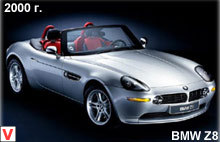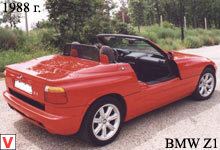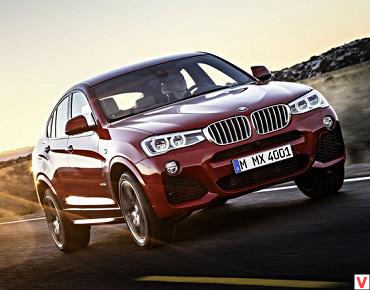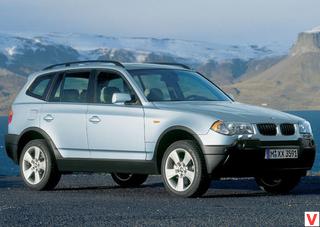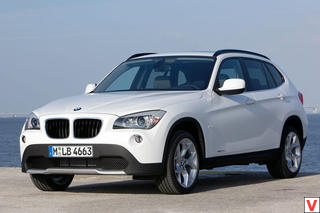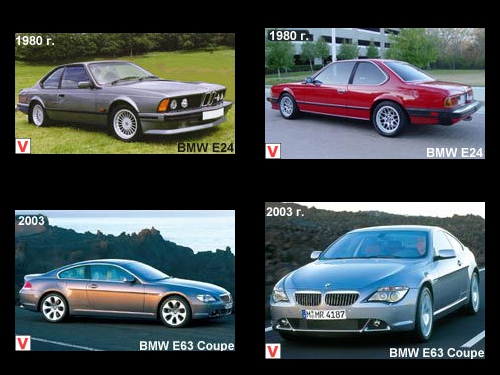
At the 1976 Geneva Motor Show, the BMW 6th series was introduced, replacing the 3.0 CSi (E9 body) in the model range. 4 years before, BMW shocked the public at the Geneva Motor Show with its concept car Turbo, which seemed to come straight from the future. This car with a wedge-shaped body and gullwing doors had a 200-hp turbo engine and a top speed of 250 km / h. It was the BMW Turbo concept car that became the basis for the design of the project with the factory designation “E24”. The prototype of the chassis design and many nodes of the "six" served as two models of the 5th series - E12 and E28.
The development of the design of the company's management team entrusted a team of stylists under the leadership of Paul Braku. This futuristic sports car, with obviously similar style decisions with the “younger” models of the 3rd and 5th series, turned out to be much more aggressive and so liked the buyers that it was made unchanged for 13 years in a row. For the predatory front with a strong negative slope of the grille, the car was called a shark.
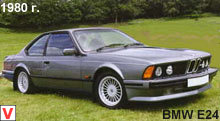
The nature of the car is quite consistent with the "shark" appearance. For the E24, the new M06 series engines were specially developed. These were inline "six" with two overhead camshafts; the valves were installed in the shape of the letter “V”, which created the correct turbulence in the combustion chamber and provided not only effective ignition of the mixture and increased power, but also smooth operation of the engine.
This also contributed to the forged crankshaft and two balance shaft. It was these perfectly balanced inline 6-cylinder engines that brought BMW fame world-wide fame. The first models on sale were the 633CSi models - in January 1976 and the 630CS - in February of the same year.
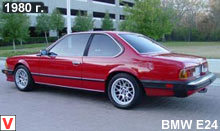
Under the hood of a BMW 633CSi, an M69 engine of 3.2 liters and 197 hp was installed. at 5500 rpm On the nameplate of the car there was a letter “i”, meaning the presence of electronic injection, transistor ignition and Bosch L-jetronic engine management system. This significantly reduced fuel consumption (633CSi consumed 10 liters per 100 km). The maximum speed of cars with this engine was 215 km / h, which corresponded to the level of good sports cars of the time. The BMW 630CS version received an M68 engine with a displacement of 3 liters and an output of 185 hp. at 5800 rpm This engine is equipped with a two-chamber two-level carburetor.
The maximum speed of the BMW 630CS is 210 km / h. Cars of the first years of production were equipped with a 4-speed manual transmission or a 3-speed automatic. Later came the 4-speed automatic and 5-speed manual. Standard equipment assumed the presence of disc brakes, and the front was ventilated. By request, it was possible to get the ABS.
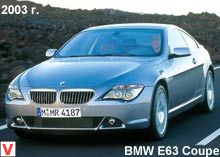
In 1978, she saw the light of the top model 635CSi, which received a 3.4-liter engine producing 218 hp. The technical characteristics of this version inspire respect even now. Torque 310 Nm at 4000 rpm. The maximum speed of 239 km / h, acceleration to 100 km / h in 7.1 seconds with a mass of about 1.5 tons.
In 1982, the engine was replaced with a similar in terms of working volume and power, but with less fuel consumption, thanks to a new control unit injector, and in 1987 there was a version with a catalyst, from which the power decreased by 7 hp up to 211 hp The 635CSi version is distinguished by a sporty-adapted chassis, a front spoiler lowered below, which, together with the spoiler on the edge of the trunk lid, reduced lift by 15%, which greatly increased safety at high speeds. In 1979, the 630CS was removed from the conveyor, so the era of carburetor engines in premium-class BMW models ended.
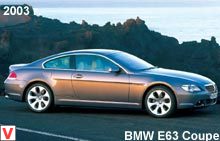
Instead, the manufacturer offered an economical 628CSi engine with an output of 184 hp, which consumed much less fuel than the 630CS. In addition, a small difference in price compared to more powerful models made the 628CSi version even more attractive. This allowed her to stay in production until 1987. Since October 1984, ABS and electric seat adjustment were set with the standard.
In the options appeared anti-skid system. In 1984, the sports version M 635CSi was announced. It used the S38B35 engine, created on the basis of the BMW M1 engine. With the help of a new control program, it was possible to “squeeze” 286 hp out of this 24-valve engine. - 9 more than in the "original".
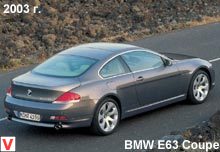
The speed of the car increased to 255 km / h, and acceleration to a hundred took 6.4 seconds. Naturally, such dynamics required chassis modifications: the M 635CSi was 11 mm lower, other shock absorbers and brakes were placed on it — 4-piston ventilated in front and larger single-piston in the rear. Externally, the car was distinguished by extended arches and symbols of the Motorsport division. In the fall of 1986, the model was renamed M6, due to the change in the classification of M-models. On April 6, 1989, after 86,216 copies, the last E24 635CSi rolled off the assembly line. Replaced the "six" came the 8th series.
In 1999, the 8th series was discontinued, and for 5 long years, the BMW model range was left without a large coupe. Finally, in August 2003, the second generation of the 6-series coupe (body E63) was presented at the Frankfurt Motor Show. Planting formula 2 + 2 (two adults + two children or luggage). As before, the coupe was created on the basis of the 5th series. The exterior includes stylistic solutions for both the Five (E60) and the G7 (E65). In 2004, the 6-series convertible (E64 body) was introduced at the Detroit show. Production started in the German city of Dingolfing. The assembly process is entirely entrusted to robots.

Particularly impressive is the process of making leather seats. The operator only sets the color scheme of the cabin, ordered by the buyer. Robots themselves choose the appropriate color of the skin, check its quality and tailor it. Meanwhile, another machine with a color-detecting detector picks up threads of the desired color and stitches all the upholstery components.
The front part of the body is made of aluminum alloys, and the front fenders and trunk lid are made of composite materials. In technical terms, the "six" of the second generation took quite a lot from the seventh series. The "Seven" borrowed Dynamic Drive's electronic control technology, the ZF automatic gearbox, and an adaptive suspension, which allows varying the stiffness of shock absorbers in a wide range. The car received a completely new ABS system, which controls each wheel independently. Of the pleasant things, there are interesting electronic systems: thrust adjustment, stability control, dynamics control, as well as active steering, a panoramic roof and a projection display.
The choice of powertrains is impressive. The most modest of the 3.0-liter petrol engines of 258 hp. installed on version 630i. This was followed by a 4.4-liter engine capacity of 333 hp. for version 645Ci, which lasted on the conveyor from 2003 to 2005, and then was replaced by version 650i with an engine of 4.8 l / 367 hp At the same time, in 2005, the top version of the M6 from the sports department of the company appeared, which was equipped with a V10 engine of 5.0 liters and a power of 507 hp. Externally, the M6 version differed from the usual coupe in a different body kit. In September 2007, the 6-series received an easy update.
Minor external and internal changes. A new engine appeared under the hood - a 3.0-liter biturbo six-cylinder diesel engine with a power of 286 hp. In the summer of 2010, production of the BMW 6 Series E63 and E64 was discontinued. The third generation was first shown at the 2010 Paris Motor Show. First came the 6 Series F12 convertible, and a little later the F13 coupe.
The car traditionally offers an attractive and modern exterior design, a high level of comfort, innovative technologies, as well as advanced active and passive safety systems. The body of the third generation features a modernized head optics, stylish exterior mirror housings, an improved suspension with sporty settings and larger dimensions. The BMW 6-series coupe still retains the 2 + 2 landing formula, with the body length and wheelbase increased by 75 millimeters compared with the previous model, making it easier for passengers to stay in the rear.
Already in the basic configuration of the car there is a high-quality audio system, immobilizer, on-board computer, 2-zone climate control, cruise control, airbags of various types, multifunctional steering wheel, full electric equipment, rain and light sensors. The line of power units is represented by both petrol and diesel modifications. All are equipped with rear or four-wheel drive, as well as an 8-speed automatic gearbox. The most powerful gasoline version of the 650i is equipped with a 4.4-liter 407-horsepower engine, from a spot to a hundred it accelerates in 4.9 seconds. The maximum speed is limited to 250 kilometers per hour.
Another 640i petrol version is equipped with a three-liter inline six-cylinder petrol engine with a capacity of 320 horsepower. Also at the disposal of the owners of a package of advanced technologies BMW EfficientDynamics, including the function of automatic shutdown and restart of the engine Auto Start Stop and ECO PRO economy mode. Both engines comply with Euro-5 toxicity standards.
In the 6 series of the third generation of new chassis design. The car received such options as: electromechanical steering with optional integral active steering; driving dynamics control system, dynamic damping control for shock absorbers and Adaptive Drive suspension control system. Among the high-tech innovations are adaptive LED headlights for low and high beam with swiveling light function, LED fog lights and taillights, rear view camera, Surround View all-round viewing system, Speed Limit Info speed limit indicator, BMW Night Vision night vision system and parking assistance system .
